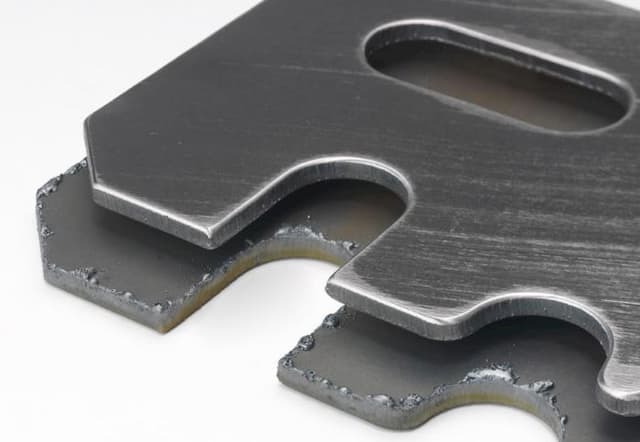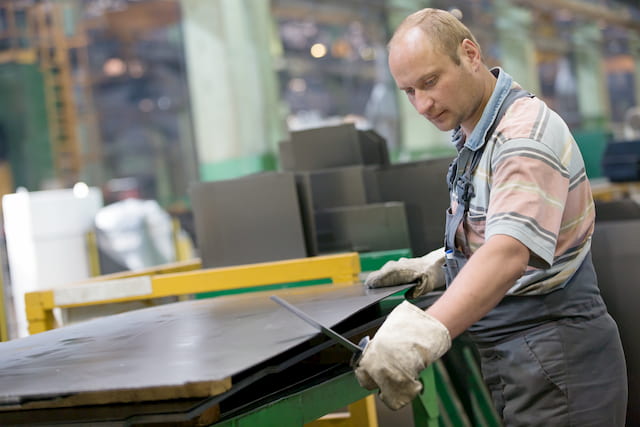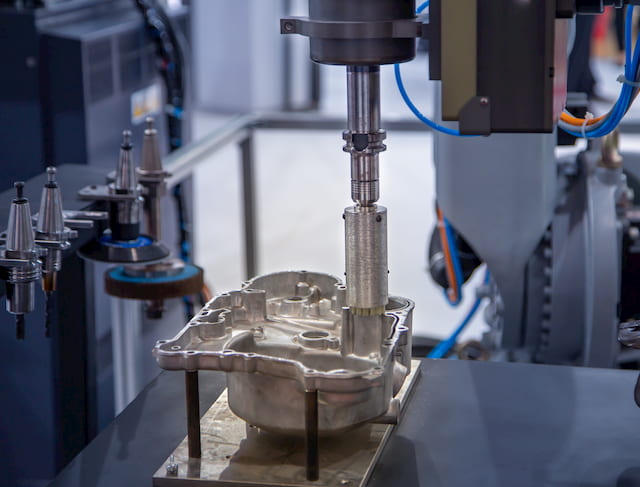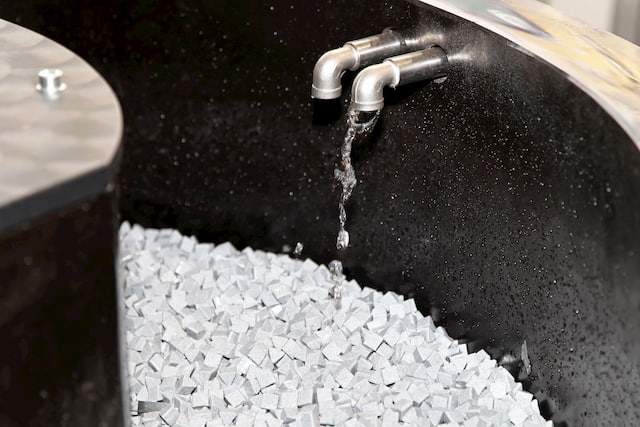While paying for a laser cutting service, you would expect a result of your money’s worth. Still, parts with sharp edges are no rarity. Sometimes it is not possible to cut without the formation of a burr. Then deburring is necessary.
Deburring comes in many forms. So does the occurrence of burrs. We are looking into both sides of the topic.
What Is a Burr?
Before we can dive into the details of the deburring process, it is important to understand what a burr is and how it affects the quality of your metal parts.

In the context of metal manufacturing, a burr refers to the formation of rough edges or ridges on the metal piece. The reason behind it lies in the manufacturing process and the tools involved in its production. It is especially common with cutting operations on sheet metal.
Burr has an important impact on the quality and performance of metal pieces. Here are some examples of the effects of burr:
- Reduced safety. Sharp metal edges result in hazardous handling for operators.
- Increased stress during operation. This results in a reduction of resistance to fractures and fatigue.
- Susceptibility to corrosion. Related to a difference in material thickness.
- Lubrication problems, especially because of contamination with burr scraps, and wear at interfaces.
- Interference when applying finishing processes like powder coating or electroplating.
Clearly, the formation of burr should be avoided whenever possible. But as a “side-product” of many manufacturing methods, it is often unavoidable. In those instances, deburring is necessary.
Which Manufacturing Methods Leave a Burr?
Burr commonly occurs when producing sheet metal parts using different manufacturing methods. Those include machining and cutting processes.
Some of the most common burr-leaving machining processes are:
Cutting processes used with sheet metal that leave burrs include:
- Laser cutting
- Plasma cutting
- Punching
- Shearing
- Blanking
It is important to note that there are factors that relate to burr formation. Therefore, not every one of those cutting methods leaves a burr. At least not always.
These factors are related to many things. The most important is probably the awareness and skills of the machine operator handling the parts and configuring the machinery. Also, a lot comes down to the material thickness and grade. Some materials are a lot easier to cut while leaving a satisfactory result without the need for post-processing.
Nevertheless, it is possible to remove burrs to achieve a smooth surface. And there are many different deburring methods to choose from. Each of them comes with advantages and disadvantages.
Deburring Methods and Tools
Looking deeper into the subject, it is clear that there is a plethora of deburring options available. The Deburring and Edge Finishing Handbook by Laroux K Gillespie tells us that there are more than 80 different processes currently in use in metal manufacturing.
Some of these methods require more manual labour while others are automated. There is also a methodical difference. You can apply thermal or mechanical methods to obtain a great result.
With that said, we list the main methods for deburring metal parts for a smooth finish.
Manual Deburring
This is the oldest and most basic method to eliminate burr. It requires a skilful craftsman to guarantee the best results. Therefore, it is a method that takes a lot of time and effort.
As a time-consuming technique, manual deburring is nowadays mostly used in small shops with a low production rate. Cleaning large batches is not cost-effective but having the required skills in the workshop may come in handy.

Common tools used to apply this method include deburring knives, files, sandpapers and other polishing tools.
Pros:
- Flexible
- Does not require expensive machines or tools
Cons:
- Only suitable for small quantities
- Only suitable for small burrs and simple structures
- Not cost-effective, especially with large batches
Punch Deburring
This method uses a punching machine to eliminate the burr. It requires different types of dies to achieve what is called punch mould work, including rough blanking dies, fine blanking dies, and sizing dies.
Pros:
- Higher productivity compared to manual deburring
- Better efficiency than manual deburring
Cons:
- Does not work with complex structures
- Requires special tools
- Personal account manager
- Quality assurance
- Payment terms for companies
- On-time delivery by Fractory
Hole Deburring
As the name suggests, this method is used when deburring is needed on the inner part of a hole. There are a variety of tools to apply this method available in the current market, but they usually have the same configuration.
A cutting tool is spring-loaded and mounted on a spindle. This tool is positioned so that it can go through the hole smoothly and comes out by touching the surface with the edge that cuts the burr without causing any type of scratches or damages. Some of the cutting tools come with a tapered end that allows the creation of a chamfer at the front of the hole when entering.
Pros:
- Fast and cost-effective
- Suitable for many pieces
- Good surface finishes
Cons:
- Only applicable on holes
- Requires special tools
Brushing
Considering the name of the method, it is easy to deduce that, in this case, the burr is eliminated by “cleaning” the surface with a special type of brush.
The method works in a similar way to manually deburring with sandpaper and similar tools. The deburring brushes are usually made of abrasive materials with a specific grit number.
The main difference is that most of these brushes are designed to be mounted on machine tools, making the process more efficient and giving the possibility of automating this manufacturing step too.

Pros:
- Fast and cost-effective
- Applicable to complex pieces with many different features like in the case of a crankshaft
- Possible to automate
- Brushes are not very expensive compared to other tools
Cons:
- More than one brush may be needed
- A tool changer must be available for increased efficiency
Electrochemical Deburring
This method, also referred to as electropolishing, is commonly used on small metal parts with a burr in areas that cannot be reached by other deburring methods. It is basically the reverse operation of plating. Instead of adding material, electrochemical deburring eliminates it.
This process uses a tool with a shape similar to the edge being deburred. The tool, in this case, an electrode, works together with an electric current and a solution of sodium chloride or sodium nitrate as an electrolyte. The burr is forcibly removed and any excess material is carried away by the flowing solution.
ARVE error: url: https://www.googleapis.com/youtube/v3/videos?part=snippet%2Cstatistics&id=UNB469qauTc&key=AIzaSyAQ7WFzTAUrOX-FjsIrFS3JwZBFzgIvloc Status code 200 expected but was 403.
Pros:
- High precision in difficult areas of the piece
- Fast
- Deburring several parts at once is possible
- No material wear on tools
- No risk of heat-affected parts
Cons:
- Only suitable for small pieces
- Requires custom tools
- Can affect non-specified areas
Tumbling
Another way to provide a great finish for your metal parts is in a vibrating or centrifugal container. The barrel contains a mixture of abrasives and liquids. Those start moving and rubbing against the metal parts due to the vibratory movement.
The result is the elimination of burrs without scratching the surface. Besides removing burrs, deburring by tumbling leaves a great overall surface finish to the parts.

The main abrasive materials include plastics, ceramics or mixtures used on finishing steel parts.
Pros:
- Less aggressive than other methods
- High efficiency
- Other imperfections are also eliminated
Cons:
- Requires special machinery
- Need various mediums for different uses
Grinding and Rolling
If you are looking for a high-quality finish without too much hassle, mechanical deburring by grinding or rolling may be for you. While somewhat similar to manual deburring, it is much faster and therefore more cost-efficient.
ARVE error: url: https://www.googleapis.com/youtube/v3/videos?part=snippet%2Cstatistics&id=NtePJgMH68Q&key=AIzaSyAQ7WFzTAUrOX-FjsIrFS3JwZBFzgIvloc Status code 200 expected but was 403.
Pros:
- Fast and simple
- Flexible and cost-effective
- High production rate
Cons:
- Suitable only for small products
- Sometimes requires further processing
Thermal Deburring
Also called Thermal Energy Method (TEM), it is a method mainly used to treat many pieces and all their surfaces at the same time. The burr is eliminated by burning the material in a controlled combustion chamber. A mixture of oxygen and natural gas is commonly used as the energy source.
The most important step is determining the right proportion of oxygen and fuel that must be used to generate enough heat to remove the burr without hurting the piece. Although the burst is short, it is enough to burn away the thin burrs with large surface areas. At the same time, other areas of the metal piece are not affected.
Pros:
- Quick and flexible
- Multiple parts at the same time
- High production rate
Cons:
- Some parts may require special care for protection
- The material removed transforms into oxide, which requires further processing
Conclusion
The most cost-effective way of working is minimising the amount of processes. Therefore, we recommend turning to a manufacturer capable of providing clean parts without burr whenever possible.
But with certain materials and thicknesses, it is just not possible. Of course, the burr is only on one side of the material. If your parts may have it on the “inside” for example, be sure to inform the producer which is the “inner side”.
Otherwise, choose a deburring method from this list. If you have a batch of parts, don’t make your staff waste their time on manual deburring and rather choose an automated method.





